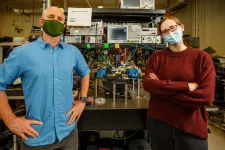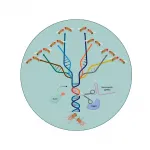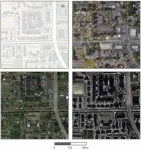Mapping intermittent methane emissions across the Permian Basin
2021-06-02
(Press-News.org) The Permian Basin, located in western Texas and southeastern New Mexico, is the largest oil- and gas-producing region in the U.S. The oilfield operations emit methane, but quantifying the greenhouse gas is difficult because of the large area and the fact that many sources are intermittent emitters. Now, researchers reporting in ACS' Environmental Science & Technology Letters have conducted an extensive airborne campaign with imaging spectrometers and identified large methane sources across this area.
According to the U.S. Energy Information Administration, 38% of the nation's total oil and 17% of natural gas production took place in the Permian Basin in 2020. Therefore, quantifying emissions from these operations, which continue to expand rapidly, is of great interest to environmental scientists. Previous studies have tried to estimate methane leakage in the Permian Basin through satellite images or mobile field studies, but either the spatial resolution was too coarse to quantify methane coming from individual sources, or the studies were limited to small areas or timeframes. So Daniel Cusworth and colleagues from the NASA Jet Propulsion Laboratory, the University of Arizona and Arizona State University formed a collaboration. They wanted to quantify strong methane point source emissions (greater than 22-44 pounds of methane per hour) in the Permian Basin using airborne imaging spectrometry, a technology that would allow high-resolution mapping of those sources across large areas and multiple overflights.
From September to November 2019, the researchers conducted repeated flights in airplanes carrying imaging spectrometers, covering about 21,000 square miles and 60,000 active wells in the Permian Basin. The spectrometers detected 1,100 unique large methane point sources that were sampled at least three times. Most of these sources were highly intermittent (detected 25% or fewer of the times sampled). However, sources that were routinely persistent (detected 50-100% of the time) comprised 11% of the methane emitters but 29% of the total detected emissions, possibly indicating leaking equipment that needs repair. Half of the detected methane came from oil and gas production wells, 38% from pipelines and other equipment used to collect and transport oil and gas, and 12% from processing plants. These results show that frequent, high-resolution monitoring is necessary to understand intermittent methane emitters across large areas and to pinpoint persistent leaks for mitigation, the researchers say.
INFORMATION:
The authors acknowledge funding from NASA, the University of Arizona, Carbon Mapper Inc. and the High Tide Foundation.
The paper's abstract will be available on June 2 at 8 a.m. Eastern time here: http://pubs.acs.org/doi/abs/10.1021/acs.estlett.1c00173
The American Chemical Society (ACS) is a nonprofit organization chartered by the U.S. Congress. ACS' mission is to advance the broader chemistry enterprise and its practitioners for the benefit of Earth and all its people. The Society is a global leader in promoting excellence in science education and providing access to chemistry-related information and research through its multiple research solutions, peer-reviewed journals, scientific conferences, eBooks and weekly news periodical Chemical & Engineering News. ACS journals are among the most cited, most trusted and most read within the scientific literature; however, ACS itself does not conduct chemical research. As a leader in scientific information solutions, its CAS division partners with global innovators to accelerate breakthroughs by curating, connecting and analyzing the world's scientific knowledge. ACS' main offices are in Washington, D.C., and Columbus, Ohio.
To automatically receive news releases from the American Chemical Society, contact newsroom@acs.org.
Follow us: Twitter | Facebook
[Attachments] See images for this press release:

ELSE PRESS RELEASES FROM THIS DATE:
2021-06-02
A healthy diet around the time of conception through the second trimester may reduce the risk of several common pregnancy complications, suggests a study by researchers at the National Institutes of Health. Expectant women in the study who scored high on any of three measures of healthy eating had lower risks for gestational diabetes, pregnancy-related blood pressure disorders and preterm birth. The study was conducted by Cuilin Zhang, M.D., Ph.D., and colleagues at NIH's Eunice Kennedy Shriver National Institute of Child Health and Human Development (NICHD). It appears in the American Journal of Clinical Nutrition. ...
2021-06-02
A team of students working with Jonathan Boreyko, associate professor in mechanical engineering at Virginia Tech, has discovered the method ducks use to suspend water in their feathers while diving, allowing them to shake it out when surfacing. The discovery opens the door for applications in marine technology. Findings were published in ACS Applied Materials & Interfaces.
Boreyko has a well-established body of work in the area of fluid mechanics, including the invention of a fog harp and the use of contained, recirculated steam as a cooling device. As his research has progressed throughout the past decade, the mechanics of duck de-wetting has been one of his longest-running projects.
"I got this idea when I was at Duke University," ...
2021-06-02
Jack Tseng loves bone-crunching animals -- hyenas are his favorite -- so when paleontologist Joseph Peterson discovered fossilized dinosaur bones that had teeth marks from a juvenile Tyrannosaurus rex, Tseng decided to try to replicate the bite marks and measure how hard those kids could actually chomp down.
Last year, he and Peterson made a metal replica of a scimitar-shaped tooth of a 13-year-old juvie T. rex, mounted it on a mechanical testing frame commonly used in engineering and materials science, and tried to crack a cow legbone with it.
Based on 17 successful attempts to match the depth and shape of the bite marks on the fossils -- he had to toss out some trials because the fresh bone slid around too much -- he determined that a juvenile could have exerted ...
2021-06-02
ALBUQUERQUE, N.M. -- Scientists at Sandia National Laboratories have built the world's smallest and best acoustic amplifier. And they did it using a concept that was all but abandoned for almost 50 years.
According to a paper published May 13 in Nature Communications, the device is more than 10 times more effective than the earlier versions. The design and future research directions hold promise for smaller wireless technology.
Modern cell phones are packed with radios to send and receive phone calls, text messages and high-speed data. The more radios in a device, the more it can do. While most radio components, including amplifiers, are electronic, they can potentially ...
2021-06-02
Twice a day, at dusk and just before dawn, a faint layer of sodium and other metals begins sinking down through the atmosphere, about 90 miles high above the city of Boulder, Colorado. The movement was captured by one of the world's most sensitive "lidar" instruments and reported today in the AGU journal Geophysical Research Letters.
The metals in those layers come originally from rocky material blasting into Earth's atmosphere from space, and the regularly appearing layers promise to help researchers understand better how earth's atmosphere interacts with space, even potentially how those interactions help support life.
"This is an important discovery because we have never seen these dusk/dawn features before, and because these metal layers affect many things. The ...
2021-06-02
DALLAS, June 2, 2021 -- A "prescription" to sit less and move more is the optimal first treatment choice for reducing mild to moderately elevated blood pressure and blood cholesterol in otherwise healthy adults, according to the new American Heart Association scientific statement published today in the American Heart Association's journal Hypertension.
"The current American Heart Association guidelines for diagnosing high blood pressure and cholesterol recognize that otherwise healthy individuals with mildly or moderately elevated levels of these ...
2021-06-02
A large group of iconic fossils widely believed to shed light on the origins of many of Earth's animals and the communities they lived in may be hiding a secret.
Scientists, led by two from the University of Portsmouth, UK, are the first to model how exceptionally well preserved fossils that record the largest and most intense burst of evolution ever seen could have been moved by mudflows.
The finding, published in Communications Earth & Environment, offers a cautionary note on how palaeontologists build a picture from the remains of the creatures they study.
Until now, it has been widely accepted the fossils buried in mudflows in the Burgess Shale in Canada that show the result of the Cambrian ...
2021-06-02
CRISPR-based technologies offer enormous potential to benefit human health and safety, from disease eradication to fortified food supplies. As one example, CRISPR-based gene drives, which are engineered to spread specific traits through targeted populations, are being developed to stop the transmission of devastating diseases such as malaria and dengue fever.
But many scientists and ethicists have raised concerns over the unchecked spread of gene drives. Once deployed in the wild, how can scientists prevent gene drives from uncontrollably spreading across populations ...
2021-06-02
CHICAGO -- Women who experience acute aortic dissection--a spontaneous and catastrophic tear in one of the body's main arteries--not only are older and have more advanced disease than men when they seek medical care, but they also are more likely to die, according to research published online today in The Annals of Thoracic Surgery.
"Data over the course of the last few decades demonstrate differences in both presentation and outcomes between males and females who have acute aortic dissection, with greater mortality among females," said Thomas G. Gleason, MD, from Brigham and Women's Hospital in Boston, Massachusetts. "This study underscores ...
2021-06-02
Can you trust the map on your smartphone, or the satellite image on your computer screen?
So far, yes, but it may only be a matter of time until the growing problem of "deep fakes" converges with geographical information science (GIS). Researchers such as Associate Professor of Geography Chengbin Deng are doing what they can to get ahead of the problem.
Deng and four colleagues -- Bo Zhao and Yifan Sun at the University of Washington, and Shaozeng Zhang and Chunxue Xu at Oregon State University -- co-authored a recent article in Cartography and Geographic Information Science that explores the problem. In "Deep ...
LAST 30 PRESS RELEASES:
[Press-News.org] Mapping intermittent methane emissions across the Permian Basin





